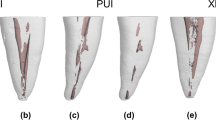Abstract
Aim
This was to compare the effectiveness of different preparations and delivery techniques of calcium hydroxide paste as an intracanal medicament in primary molar root canals.
Methods
Extracted lower primary second molars roots (72) were randomly assigned to the four experimental groups. After complete root canal preparation with TF rotary nickel titanium up to .06/30 file, a mix of calcium hydroxide/ distilled water was delivered by lentulo spiral (group 1) or a syringe (group 2). UltraCal® XS was placed by lentulo spiral (group 3) and a syringe (group 4). Digital radiographs were taken in both buccal and proximal directions before and after calcium hydroxide placement to evaluate the quality of filling. The mean percentages of filled calcium hydroxide area by subtracted digital radiograph, and the quality assessments between four experimental groups, were compared by using Two-way ANOVA and Fisher’s exact test respectively. A p value of less than 0.05 was considered statistical significance.
Results
There was no statistically significant difference in the mean percentages of the filled calcium hydroxide area among different preparations and delivery techniques (p ≥ 0.05). The syringe technique had statistically significant fewer of air inclusions than when using the lentulo spiral with the mix of calcium hydroxide group (p < 0.05). The completeness of obturation and the quality of filling at apical part were not different among groups (p ≥ 0.05).
Conclusion
Syringe technique was a simpler handling method that presented similar filling quality but fewer porosities than lentulo spiral technique in primary molar root canals.
Similar content being viewed by others
References
Bawazir OA, Salama FS. Clinical evaluation of root canal obturation methods in primary teeth. Pediatr Dent. 2006;28(1):39–47.
Bystrom A, Claesson R, Sundqvist G. The antibacterial effect of camphorated paramonochlorophenol, camphorated phenol and calcium hydroxide in the treatment of infected root canals. Endod Dent Traumatol. 1985;1(5):170–5.
Foreman PC, Barnes IE. Review of calcium hydroxide. Int Endod J. 1990;23(6):283–97.
Guelmann M, McEachern M, Turner C. Pulpectomies in primary incisors using three delivery systems: an in vitro study. J Clin Pediatr Dent. 2004;28(4):323–6.
Hargreaves KM, Cohen S, Berman LH. Cohen’s Pathways of the Pulp. 10th ed. Misssori: Mosby Elsevier; 2011.
Kahn FH, Rosenberg PA, Schertzer L, Korthals G, Nguyen PN. An in vitro evaluation of sealer placement methods. Int Endod J. 1997;30(3):181–6.
Memarpour M, Shahidi S, Meshki R. Comparison of different obturation techniques for primary molars by digital radiography. Pediatr Dent. 2013;35(3):236–40.
Messer HH, Chen RS. The duration of effectiveness of root canal medicaments. J Endod. 1984;10(6):240–5.
Oztan MD, Akman A, Dalat D. Intracanal placement of calcium hydroxide: a comparison of two different mixtures and carriers. Oral Surg Oral Med Oral Pathol Oral Radiol Endod. 2002;94(1):93–7.
Parashos P, Messer HH. Rotary NiTi instrument fracture and its consequences. J Endod. 2006;32(11):1031–43.
Pruett JP, Clement DJ, Carnes DL Jr. Cyclic fatigue testing of nickel-titanium endodontic instruments. J Endod. 1997;23(2):77–85.
Rodd HD, Waterhouse PJ, Fuks AB, Fayle SA, Moffat MA. Pulp therapy for primary molars. Int J Paediatr Dent. 2006;16(Suppl 1):15–23.
Simcock RM, Hicks ML. Delivery of calcium hydroxide: comparison of four filling techniques. J Endod. 2006;32(7):680–2.
Siqueira JF Jr, Lopes HP. Mechanisms of antimicrobial activity of calcium hydroxide: a critical review. Int Endod J. 1999;32(5):361–9.
Staehle HJ, Thoma C, Muller HP. Comparative in vitro investigation of different methods for temporary root canal filling with aqueous suspensions of calcium hydroxide. Endod Dent Traumatol. 1997;13(3):106–12.
Torres CP, Apicella MJ, Yancich PP, Parker MH. Intracanal placement of calcium hydroxide: a comparison of techniques, revisited. J Endod. 2004;30(4):225–7.
Tzanetakis GN, Kontakiotis EG, Maurikou DV, Marzelou MP. Prevalence and management of instrument fracture in the postgraduate endodontic program at the Dental School of Athens: a five-year retrospective clinical study. J Endod. 2008;34(6):675–8.
Welbury R, Hosey MT. Paediatric dentistry. 3rd ed. New York: Oxford University Press; 2005.
Author information
Authors and Affiliations
Corresponding author
Rights and permissions
About this article
Cite this article
Smutkeeree, A., Phajongviriyatorn, P., Komoltri, C. et al. Calcium hydroxide medication in primary molars using different preparations and placement techniques: an in vitro study. Eur Arch Paediatr Dent 16, 313–318 (2015). https://doi.org/10.1007/s40368-014-0163-7
Received:
Accepted:
Published:
Issue Date:
DOI: https://doi.org/10.1007/s40368-014-0163-7




